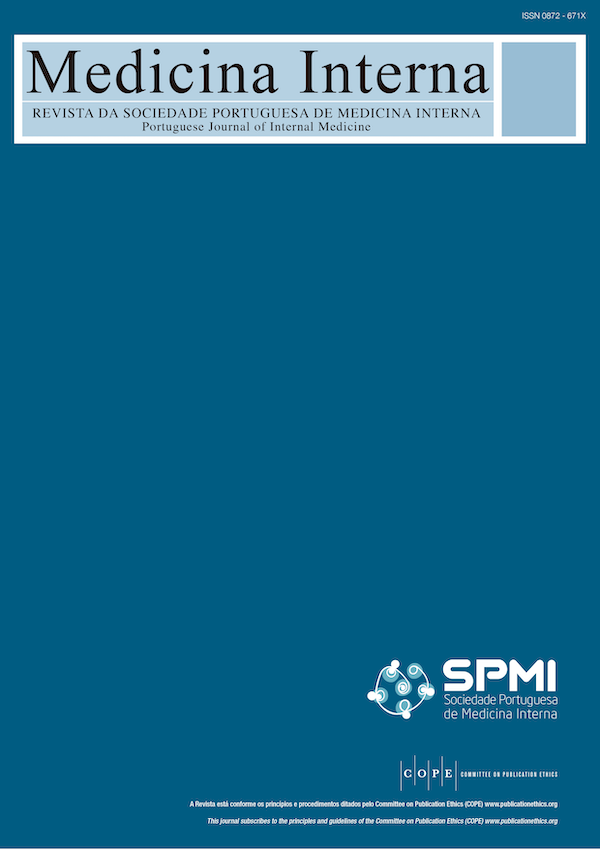Artery of Percheron Infarction: Case Report
DOI:
https://doi.org/10.24950/CC/214/20/2/2021Keywords:
Cerebral Infarction/diagnostic imaging, Magnetic Resonance Imaging, Posterior Cerebral Artery/diagnostic imagingAbstract
The artery of Percheron (AOP) is a normal variant that supplies the thalamus. AOP infarcts may originate a spectrum of unusual clinical presentations. The diagnosis is difficult due to the lack of sensitivity of detection by CT scan and to the lack of acknowledgment of this clinical entity. We describe the case of a patient who presented with unresponsiveness due to an AOP infarct. Our report serves as a reminder to consider AOP infarct as differential diagnosis when assessing patients with unspecific neurological deficits of unclear origin. Further we reinforce the claim for a low threshold for MRI in patients presenting acutely with otherwise unexplainable neurological symptoms to facilitate diagnosis and decrease patient morbidity.
Downloads
References
Amin OS, Shwani SS, Zangana HM, Hussein EM, Ameen NA. Bilateral infarction of paramedian thalami: a report of two cases of artery of Percheron occlusion and review of the literature. BMJ Case Rep. 2011;2011:bcr0920103304. doi: 10.1136/bcr.09.2010.3304.
Cassourret G, Prunet B, Sbardella F, Bordes J, Maurin O, Boret H. Ischemic Stroke of the Artery of Percheron with Normal Initial MRI: A Case Report. Case Rep Med.2010:425734.
Godani M, Auci A, Torri T, Jensen S, Del Sette M. Coma with Vertical Gaze Palsy: Relevance of Angio-CT in Acute Percheron Artery Syndrome. Case Rep Neurol. 2010;2:74–9.
Kocaeli H, Yilmazlar S, Kuytu T, Korfali E. The artery of Percheron revisited: A cadaveric anatomical study. Acta Neurochir. 2013; 155:533-9. doi:
1007/s00701-012-1548-1.
Vinod K V, Kaaviya R, Arpita B. Artery of Percheron Infarction. Ann Neurosci. 2016;23:124–6.
Yamamoto Y, Georgiadis AL, Chang HM, Caplan LR. Posterior cerebral artery territory infarcts in the New England Medical Center Posterior Circulation Registry. Arch Neurol. 1999;56:824–32.
Chen XY, Wang Q, Wang X, Wong KS. Clinical Features of Thalamic Stroke. Curr Treat Options Neurol. 2017;19:5.
Hammersley D, Arora A, Dissanayake M, Sengupta N. Fluctuating drowsiness following cardiac catheterisation: artery of Percheron ischaemic
stroke causing bilateral thalamic infarcts. BMJ Case Rep. 2017;2017:bcr2016218035. doi: 10.1136/bcr-2016-218035.
Bailey J, Khadjooi K. Lesson of the month 1: Artery of Percheron occlusion - an -uncommon cause of coma in a middle-aged man. Clin Med.
;16:86–7.
Kopelman MD. What does a comparison of the alcoholic Korsakoff syndrome and thalamic infarction tell us about thalamic amnesia? Neurosci Biobehav Rev. 2015;54:46–56.
Zhou Y, Fox D, Anand A, Elhaj A, Kapoor A, Najibi F, et al. Artery of Percheron Infarction as an Unusual Cause of Korsakoff’s Syndrome. Case
Rep Neurol Med. 2015:927809.
Turner J, Richardson T, Kane I, Vundavalli S. Decreased consciousness: bilateral thalamic infarction and its relation to the artery of Percheron.
BMJ Case Rep. 2014;2014:bcr2013201848. doi: 10.1136/bcr-2013-201848.
Zappella N, Merceron S, Nifle C, Hilly-Ginoux J, Bruneel F, Troché G, et al. Artery of Percheron infarction as an unusual cause of coma: three cases and literature review. Neurocrit Care. 2014;20:494–501.
Krampla W, Schmidbauer B, Hruby W. Ischaemic stroke of the artery of Percheron (2007: 10b). Eur Radiol. 2008;18:192–4.
Xu Z, Sun L, Duan Y, Zhang J, Zhang M, Cai X. Assessment of Percheron infarction in images and clinical findings. J Neurol Sci. 2017;383:87–92.
Downloads
Published
How to Cite
Issue
Section
License

This work is licensed under a Creative Commons Attribution 4.0 International License.
Copyright (c) 2023 Medicina Interna






